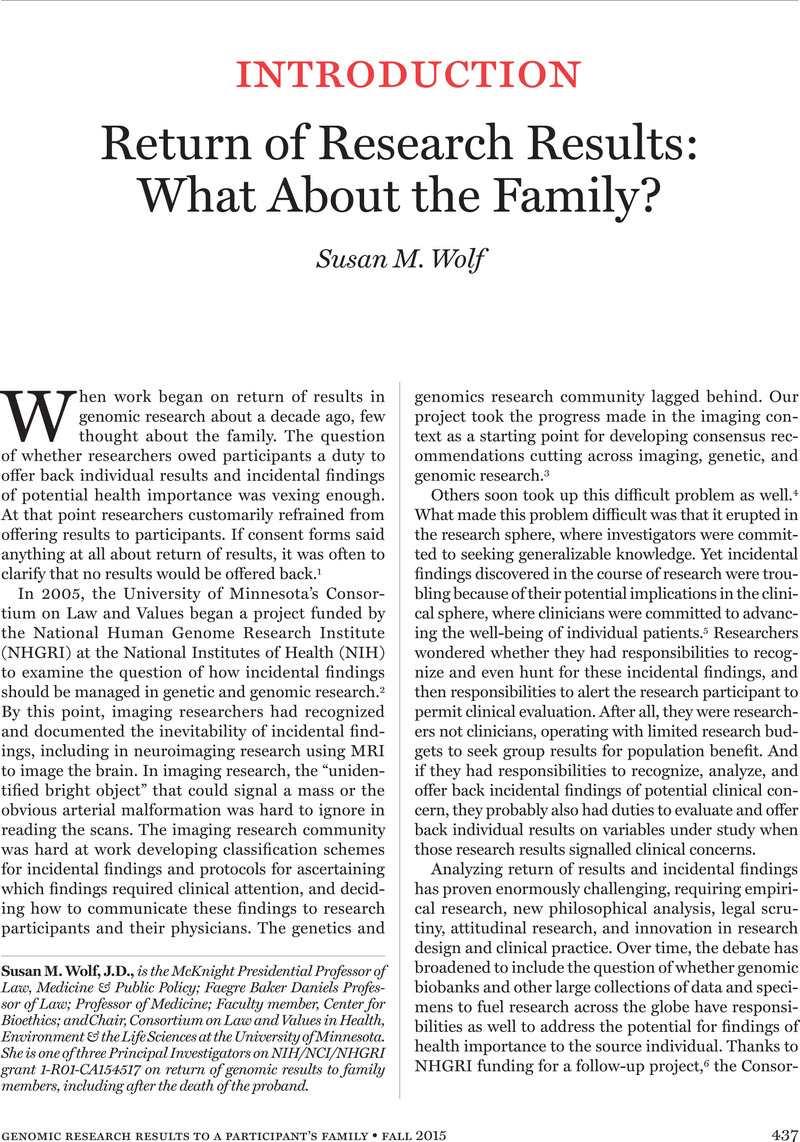Crossref Citations
This article has been cited by the following publications. This list is generated based on data provided by Crossref.
Green, Robert C.
Goddard, Katrina A.B.
Jarvik, Gail P.
Amendola, Laura M.
Appelbaum, Paul S.
Berg, Jonathan S.
Bernhardt, Barbara A.
Biesecker, Leslie G.
Biswas, Sawona
Blout, Carrie L.
Bowling, Kevin M.
Brothers, Kyle B.
Burke, Wylie
Caga-anan, Charlisse F.
Chinnaiyan, Arul M.
Chung, Wendy K.
Clayton, Ellen W.
Cooper, Gregory M.
East, Kelly
Evans, James P.
Fullerton, Stephanie M.
Garraway, Levi A.
Garrett, Jeremy R.
Gray, Stacy W.
Henderson, Gail E.
Hindorff, Lucia A.
Holm, Ingrid A.
Lewis, Michelle Huckaby
Hutter, Carolyn M.
Janne, Pasi A.
Joffe, Steven
Kaufman, David
Knoppers, Bartha M.
Koenig, Barbara A.
Krantz, Ian D.
Manolio, Teri A.
McCullough, Laurence
McEwen, Jean
McGuire, Amy
Muzny, Donna
Myers, Richard M.
Nickerson, Deborah A.
Ou, Jeffrey
Parsons, Donald W.
Petersen, Gloria M.
Plon, Sharon E.
Rehm, Heidi L.
Roberts, J. Scott
Robinson, Dan
Salama, Joseph S.
Scollon, Sarah
Sharp, Richard R.
Shirts, Brian
Spinner, Nancy B.
Tabor, Holly K.
Tarczy-Hornoch, Peter
Veenstra, David L.
Wagle, Nikhil
Weck, Karen
Wilfond, Benjamin S.
Wilhelmsen, Kirk
Wolf, Susan M.
Wynn, Julia
Yu, Joon-Ho
Amaral, Michelle
Amendola, Laura
Appelbaum, Paul S.
Aronson, Samuel J.
Arora, Shubhangi
Azzariti, Danielle R.
Barsh, Greg S.
Bebin, E.M.
Biesecker, Barbara B.
Biesecker, Leslie G.
Biswas, Sawona
Blout, Carrie L.
Bowling, Kevin M.
Brothers, Kyle B.
Brown, Brian L.
Burt, Amber A.
Byers, Peter H.
Caga-anan, Charlisse F.
Calikoglu, Muge G.
Carlson, Sara J.
Chahin, Nizar
Chinnaiyan, Arul M.
Christensen, Kurt D.
Chung, Wendy
Cirino, Allison L.
Clayton, Ellen
Conlin, Laura K.
Cooper, Greg M.
Crosslin, David R.
Davis, James V.
Davis, Kelly
Deardorff, Matthew A.
Devkota, Batsal
De Vries, Raymond
Diamond, Pamela
Dorschner, Michael O.
Dugan, Noreen P.
Dukhovny, Dmitry
Dulik, Matthew C.
East, Kelly M.
Rivera-Munoz, Edgar A.
Evans, Barbara
Evans, James P.
Everett, Jessica
Exe, Nicole
Fan, Zheng
Feuerman, Lindsay Z.
Filipski, Kelly
Finnila, Candice R.
Fishler, Kristen
Fullerton, Stephanie M.
Ghrundmeier, Bob
Giles, Karen
Gilmore, Marian J.
Girnary, Zahra S.
Goddard, Katrina
Gonsalves, Steven
Gordon, Adam S.
Gornick, Michele C.
Grady, William M.
Gray, David E.
Gray, Stacy W.
Green, Robert
Greenwood, Robert S.
Gutierrez, Amanda M.
Han, Paul
Hart, Ragan
Heagerty, Patrick
Henderson, Gail E.
Hensman, Naomi
Hiatt, Susan M.
Himes, Patricia
Hindorff, Lucia A.
Hisama, Fuki M.
Ho, Carolyn Y.
Hoffman-Andrews, Lily B.
Holm, Ingrid A.
Hong, Celine
Horike-Pyne, Martha J.
Hull, Sara
Hutter, Carolyn M.
Jamal, Seema
Jarvik, Gail P.
Jensen, Brian C.
Joffe, Steve
Johnston, Jennifer
Karavite, Dean
Kauffman, Tia L.
Kaufman, Dave
Kelley, Whitley
Kim, Jerry H.
Kirby, Christine
Klein, William
Knoppers, Bartha
Koenig, Barbara A.
Kong, Sek Won
Krantz, Ian
Krier, Joel B.
Lamb, Neil E.
Lambert, Michele P.
Le, Lan Q.
Lebo, Matthew S.
Lee, Alexander
Lee, Kaitlyn B.
Lennon, Niall
Leo, Michael C.
Leppig, Kathleen A.
Lewis, Katie
Lewis, Michelle
Lindeman, Neal I.
Lockhart, Nicole
Lonigro, Bob
Lose, Edward J.
Lupo, Philip J.
Rodriguez, Laura Lyman
Lynch, Frances
Machini, Kalotina
MacRae, Calum
Manolio, Teri A.
Marchuk, Daniel S.
Martinez, Josue N.
Masino, Aaron
McCullough, Laurence
McEwen, Jean
McGuire, Amy
McLaughlin, Heather M.
McMullen, Carmit
Mieczkowski, Piotr A.
Miller, Jeff
Miller, Victoria A.
Mody, Rajen
Mooney, Sean D.
Moore, Elizabeth G.
Morris, Elissa
Murray, Michael
Muzny, Donna
Myers, Richard M.
Ng, David
Nickerson, Deborah A.
Oliver, Nelly M.
Ou, Jeffrey
Parsons, Will
Patrick, Donald L.
Pennington, Jeffrey
Perry, Denise L.
Petersen, Gloria
Plon, Sharon
Porter, Katie
Powell, Bradford C.
Punj, Sumit
Breitkopf, Carmen Radecki
Raesz-Martinez, Robin A.
Raskind, Wendy H.
Rehm, Heidi L.
Reigar, Dean A.
Reiss, Jacob A.
Rich, Carla A.
Richards, Carolyn Sue
Rini, Christine
Roberts, Scott
Robertson, Peggy D.
Robinson, Dan
Robinson, Jill O.
Robinson, Marguerite E.
Roche, Myra I.
Romasko, Edward J.
Rosenthal, Elisabeth A.
Salama, Joseph
Scarano, Maria I.
Schneider, Jennifer
Scollon, Sarah
Seidman, Christine E.
Seifert, Bryce A.
Sharp, Richard R.
Shirts, Brian H.
Sholl, Lynette M.
Siddiqui, Javed
Silverman, Elian
Simmons, Shirley
Simons, Janae V.
Skinner, Debra
Spinner, Nancy B.
Stoffel, Elena
Strande, Natasha T.
Sunyaev, Shamil
Sybert, Virginia P.
Taber, Jennifer
Tabor, Holly K.
Tarczy-Hornoch, Peter
Taylor, Deanne M.
Tilley, Christian R.
Tomlinson, Ashley
Trinidad, Susan
Tsai, Ellen
Ubel, Peter
Van Allen, Eliezer M.
Vassy, Jason L.
Vats, Pankaj
Veenstra, David L.
Vetter, Victoria L.
Vries, Raymond D.
Wagle, Nikhil
Walser, Sarah A.
Walsh, Rebecca C.
Weck, Karen
Werner-Lin, Allison
Whittle, Jana
Wilfond, Ben
Wilhelmsen, Kirk C.
Wolf, Susan M.
Wynn, Julia
Yang, Yaping
Young, Carol
Yu, Joon-Ho
and
Zikmund-Fisher, Brian J.
2016.
Clinical Sequencing Exploratory Research Consortium: Accelerating Evidence-Based Practice of Genomic Medicine.
The American Journal of Human Genetics,
Vol. 98,
Issue. 6,
p.
1051.
Wolf, Susan M.
Scholtes, Emily
Koenig, Barbara A.
Petersen, Gloria M.
Berry, Susan A.
Beskow, Laura M.
Daly, Mary B.
Fernandez, Conrad V.
Green, Robert C.
LeRoy, Bonnie S.
Lindor, Noralane M.
O'Rourke, P. Pearl
Breitkopf, Carmen Radecki
Rothstein, Mark A.
Van Ness, Brian
and
Wilfond, Benjamin S.
2018.
Pragmatic Tools for Sharing Genomic Research Results with the Relatives of Living and Deceased Research Participants.
Journal of Law, Medicine & Ethics,
Vol. 46,
Issue. 1,
p.
87.
Liddell, Kathleen
and
Skopek, Jeffrey M
2018.
Encyclopedia of Life Sciences.
p.
1.
Gordon, Deborah R.
Radecki Breitkopf, Carmen
Robinson, Marguerite
Petersen, Wesley O.
Egginton, Jason S.
Chaffee, Kari G.
Petersen, Gloria M.
Wolf, Susan M.
and
Koenig, Barbara A.
2019.
Should Researchers Offer Results to Family Members of Cancer Biobank Participants? A Mixed-Methods Study of Proband and Family Preferences.
AJOB Empirical Bioethics,
Vol. 10,
Issue. 1,
p.
1.
Bogicevic, Ivana
Rohrberg, Kristoffer Staal
Høgdall, Estrid
and
Svendsen, Mette N.
2021.
The somatic mode: doing good in targeted cancer therapy.
New Genetics and Society,
Vol. 40,
Issue. 2,
p.
178.
Gordon, Deborah R.
and
Koenig, Barbara A.
2022.
“If relatives inherited the gene, they should inherit the data.” Bringing the family into the room where bioethics happens.
New Genetics and Society,
Vol. 41,
Issue. 1,
p.
23.





